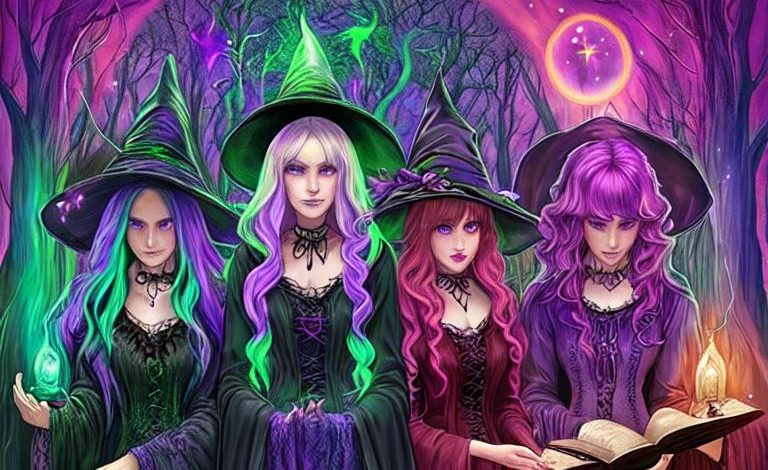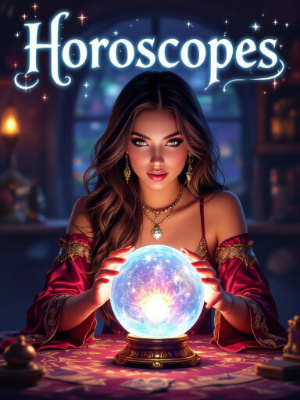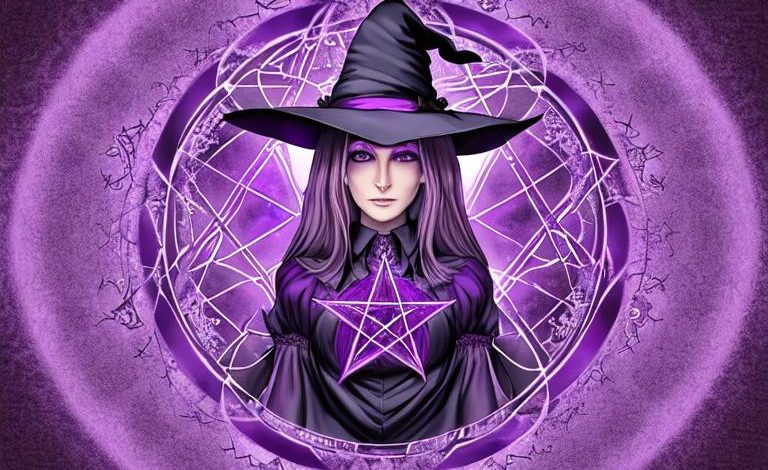
The pentagram is a five-pointed star that has been used in various cultures and religions for centuries. In modern times, the pentagram has become a symbol of witchcraft and is often associated with the practice of magic. This article will explore the history of the pentagram and its connection to witchcraft.
The pentagram has been used as a symbol for many different things throughout history. In ancient Babylon, the pentagram was used as a symbol for the five planets visible to the naked eye. The Greeks used the pentagram to represent the five elements of earth, air, fire, water, and spirit. In Christianity, the pentagram was used to represent the five wounds of Christ.
In witchcraft, the pentagram is often used as a symbol of protection and power. The pentagram is drawn with one point facing upwards, which represents the spirit or the divine, and the other four points representing the elements of earth, air, fire, and water.
Some witches believe that the pentagram can be used to invoke spirits or to cast spells. When used in a magical ritual, the pentagram is often drawn on the ground or on a piece of paper or cloth. The witch will then stand in the center of the pentagram and recite a spell or incantation.
The pentagram is also used in many different types of witchcraft, including Wicca and ceremonial magic. In Wicca, the pentagram is often used as a symbol of the Goddess, who represents the feminine aspects of the universe. In ceremonial magic, the pentagram is used as a symbol of the elements and is often associated with the four archangels.
Despite its association with witchcraft, the pentagram is not inherently evil or negative. It is simply a symbol that has been used by many different cultures and religions throughout history. In fact, many witches believe that the pentagram is a symbol of harmony and balance.
There are many different types of pentagrams, each with its own meaning and symbolism. For example, the inverted pentagram, where the point is facing downwards, is often associated with Satanism and is considered by some to be a symbol of evil. However, in some traditions of witchcraft, the inverted pentagram is used to represent the descent of spirit into matter.
In addition to its use in witchcraft, the pentagram has also been used as a symbol of rebellion and counterculture. In the 1960s, the pentagram was adopted by the counterculture movement as a symbol of nonconformity and resistance to authority.
Despite its long history and varied symbolism, the pentagram remains a controversial symbol in many parts of the world. Some people still view the pentagram as a symbol of evil or witchcraft, and there have been cases of discrimination and persecution against people who wear or display the pentagram.
The pentagram is a fascinating symbol with a rich history and diverse meanings. Whether used as a symbol of protection, power, or rebellion, the pentagram remains an important symbol in many different cultures and religions around the world.
History of the Pentagram in Witchcraft
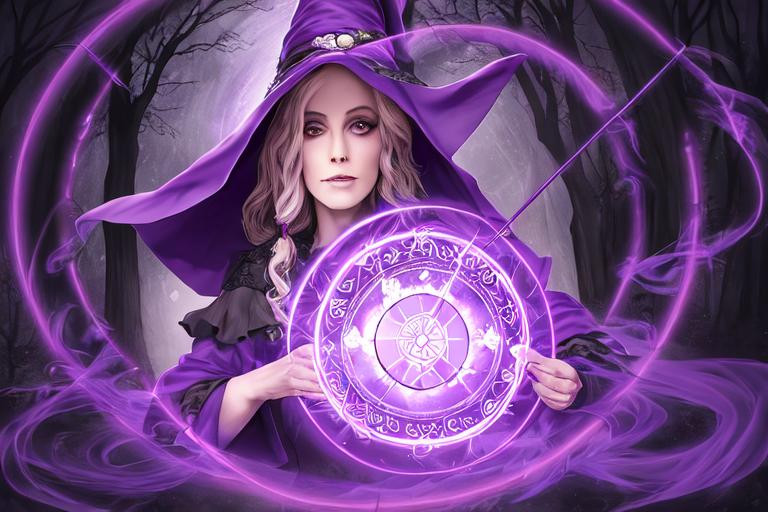
The pentagram is a symbol that has been associated with magic and witchcraft for centuries. Its origins can be traced back to ancient civilizations such as Babylon, where it was used as a symbol of the goddess Ishtar. The pentagram was also used in ancient Greece as a symbol of the goddess Venus.
In medieval Europe, the pentagram was associated with the five wounds of Christ and was used as a symbol of protection against evil. It was often carved into amulets and used to ward off demons and other malevolent spirits.
During the Renaissance, the pentagram became associated with the concept of magic and the study of the occult. The Italian philosopher and occultist Giordano Bruno used the pentagram as a symbol of the five elements (earth, air, fire, water, and spirit) and their interrelationships.
In the 19th and 20th centuries, the pentagram was adopted by various magical and occult groups, including the Hermetic Order of the Golden Dawn, Aleister Crowley’s Thelema, and the modern Wiccan movement. In these traditions, the pentagram is often used as a symbol of protection, as well as a tool for invoking spirits and casting spells.
In Wicca, the pentagram is one of the most important symbols of the religion. It is often inscribed on ritual tools and used to represent the five elements and the five points of human existence (mind, body, spirit, emotions, and will). In many Wiccan traditions, the pentagram is also used as a symbol of the goddess, with the five points representing her head, arms, and legs.
The pentagram has also been associated with Satanism and other forms of dark magic. In these contexts, the pentagram is often inverted (with two points facing upwards) to represent the descent of the spirit into matter, or the reversal of traditional morality. However, it is important to note that not all inverted pentagrams are associated with Satanism or other negative forces, and many practitioners of magic use the inverted pentagram as a symbol of transformation or initiation.
In recent years, the pentagram has become a popular symbol in popular culture, appearing in movies, TV shows, and music videos. However, its association with magic and witchcraft has also made it a target for controversy and misunderstanding. Some people still associate the pentagram with Satanism and other negative forces, while others see it as a harmless symbol of creativity and self-expression.
Despite its long and complicated history, the pentagram remains an important symbol in the practice of magic and witchcraft. Whether used for protection, invoking spirits, or casting spells, the pentagram continues to inspire and captivate practitioners of magic around the world.
Different Interpretations of the Pentagram
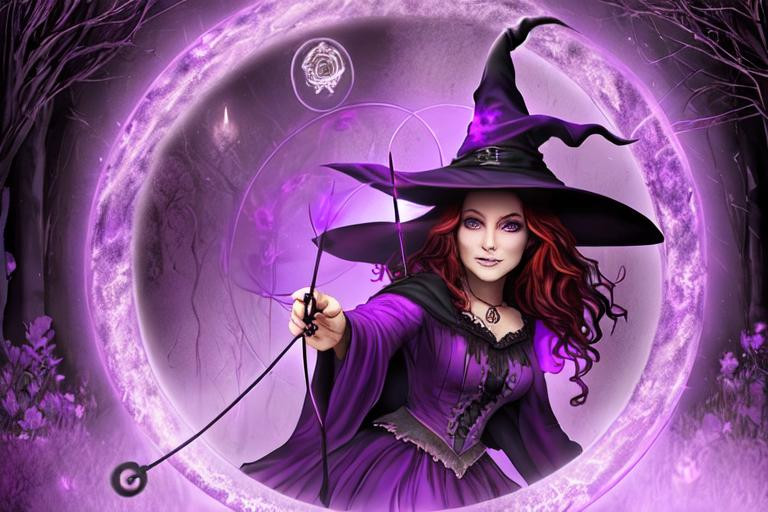
The pentagram is a symbol that has been interpreted in a variety of ways across different magical traditions. Here are some of the most common interpretations:
Wicca: In Wicca, the pentagram is one of the most important symbols of the religion. It is often used to represent the five elements (earth, air, fire, water, and spirit) and their interrelationships. The upward-pointing pentagram is used to symbolize the elements working in harmony, while the downward-pointing pentagram is used to symbolize the elements working against each other.
Satanism: In Satanism, the pentagram is often inverted (with two points facing upwards) to represent the descent of the spirit into matter, or the reversal of traditional morality. It is sometimes called the “Sigil of Baphomet” and is associated with the worship of the devil or other negative forces. However, it is important to note that not all inverted pentagrams are associated with Satanism or other negative forces.
Ceremonial Magic: In ceremonial magic, the pentagram is often used as a tool for invoking spirits and casting spells. It is sometimes inscribed on magical wands, athames (ritual knives), and other tools used in the practice of magic.
Thelema: In Thelemic magic, the pentagram is used as a symbol of the microcosm (the individual) and the macrocosm (the universe). It is often inscribed with the letters of the Hebrew word for “man” (Adam) and is used in various rituals and ceremonies.
Alchemy: In alchemy, the pentagram is used to represent the five elements and their interactions. It is often inscribed on alchemical vessels and used in the practice of transmutation.
Modern Witchcraft: In modern witchcraft, the pentagram is often used as a symbol of protection and as a talisman for warding off negative energy. It is sometimes inscribed on candles, amulets, and other objects used in spells and rituals.
Christian Symbolism: In Christian symbolism, the pentagram is sometimes used as a symbol of the five wounds of Christ. It is also associated with the concept of the Holy Trinity (Father, Son, and Holy Spirit) and is sometimes inscribed with the letters of the Greek word for “Christ.”
Astrology: In astrology, the pentagram is sometimes used to represent the five classical planets (Mercury, Venus, Mars, Jupiter, and Saturn). Each point of the pentagram is associated with one of the planets and its corresponding astrological qualities.
As these interpretations demonstrate, the pentagram is a symbol with a long and varied history in magic and witchcraft. While its exact meaning may vary depending on the context in which it is used, it remains a powerful and evocative symbol for practitioners of magic around the world.
Magic and Pentagrams
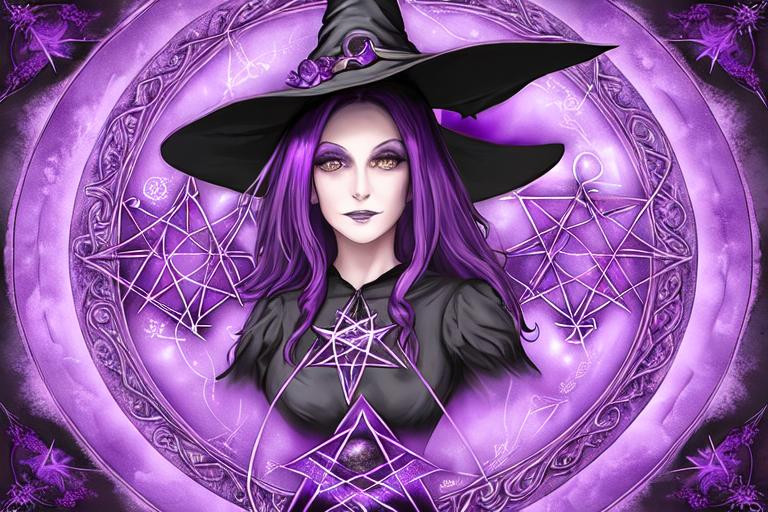
The pentagram has long been associated with magic and the practice of witchcraft. In many traditions of magic, the pentagram is used as a powerful symbol for invoking spirits and casting spells.
One of the most common uses of the pentagram in magic is as a protective symbol. When drawn with one point facing upwards, the pentagram is said to create a protective barrier around the practitioner, keeping negative energies and malevolent spirits at bay.
In addition to its use as a protective symbol, the pentagram is also used as a tool for invoking spirits and entities from other planes of existence. When drawn on the ground or on a piece of paper, the pentagram is often used as a gateway or portal for spirits to enter our world.
To invoke a spirit using the pentagram, the practitioner will typically stand in the center of the pentagram and recite a specific invocation or spell. This will often involve calling upon the spirit by name and asking it to appear before the practitioner.
Once the spirit has been summoned, the practitioner may then communicate with it or ask it to perform a specific task or favor. However, it is important to note that working with spirits can be dangerous, and practitioners should always take precautions to protect themselves and their surroundings.
In addition to its use in summoning spirits, the pentagram is also used as a tool for casting spells. When used in this way, the practitioner will often draw the pentagram in the air or on a piece of paper, and then recite a specific incantation or spell.
The pentagram is often used in conjunction with other symbols and tools, such as candles, crystals, and herbs. By combining these different elements, the practitioner can create a powerful and effective spell that can manifest their desires and intentions.
Some practitioners also use the pentagram as a symbol for the four classical elements of earth, air, fire, and water, as well as the fifth element of spirit. Each of these elements is said to have its own unique properties and energies, and can be used in different ways in magic.
For example, earth is associated with grounding and stability, while air is associated with communication and intellect. Fire is associated with passion and creativity, while water is associated with emotions and intuition. Spirit, on the other hand, is associated with the divine and with higher consciousness.
In addition to its use in spellcasting, the pentagram is also used in many different types of magic, including sigil magic, chaos magic, and ceremonial magic. Each of these types of magic has its own unique practices and techniques, but all share a common focus on harnessing the power of the universe to achieve desired outcomes.
The pentagram is a powerful and versatile symbol that has been used in magic and witchcraft for centuries. Whether used for protection, summoning spirits, or casting spells, the pentagram remains an important tool for practitioners of magic around the world. However, it is important to remember that magic can be dangerous, and should always be approached with caution and respect.
Invoking pentagram
The invoking ritual requires you to draw a pentagram in the air using a sword or athame, beginning at the top point of the pentagram you trace the shape of the pentagram in an anti-clockwise direction, finishing at the top point. Your invoking pentagram is then complete.
Banishing pentagram
The banishing ritual requires you to draw the pentagram in the air while holding the athame, but in reverse order to the invoking. To banish you begin at the bottom left point of the pentagram and trace the shape in a clockwise direction, finishing at the bottom left point. Your banishing pentagram is then complete.
The Elements
Each direction has a particular power and association, Spirit, Air, Water, Fire, Earth, and these elements may be invoked during rituals. There is a specific invoking pentagram associated with each element. You may perform invoking and banishing pentagrams.
Invoking Spirit – Hold your athame in the air, beginning at the bottom right point trace the pentagram in the air, moving it clockwise along each point until you finish at the bottom right.
Invoking Earth – Hold your athame in the air, beginning at the top point trace the pentagram in the air, moving it anti-clockwise along each point until you finish at the top point.
Invoking Air – Hold your athame in the air, beginning at the far right point trace the pentagram in the air, moving it anti-clockwise along each point until you finish at the far right point.
Invoking Fire – Hold your athame in the air, beginning at the top point trace the pentagram in the air, moving it clockwise along each point until you finish at the top point.
Invoking Water – Hold your athame in the air, beginning at the far left point trace the pentagram in the air, moving it clockwise along each point until you finish at the far left point.
Banishing Spirit – Hold your athame in the air, beginning at the bottom left point trace the pentagram in the air, moving it anti-clockwise along each point until you finish at the bottom left.
Banishing Earth – Hold you athame in the air, beginning at the bottom left point trace the pentagram in the air, moving it clockwise along each point until you finish at the bottom left point.
Banishing Air – Hold your athame in the air, beginning at the far left point trace the pentagram in the air, moving it clockwise along each point until you finish at the far left point.
Banishing Fire – Hold your athame in the air, beginning at the bottom right point trace the pentagram in the air, moving it anti-clockwise along each point until you finish at the bottom right point.
Banishing Water – Hold your athame in the air, beginning at the far right point trace the pentagram in the air, moving it anti-clockwise along each point until you finish at the far right point.
When performing any type of ritual a pentacle can be worn for protection and empowerment. If you wear a pentagram on a daily basis it is up to you whether you are discreet or want to wave the witch’s flag.
Final Musings
As witches, we understand the power and symbolism of the pentagram. It is a symbol that has been used for centuries in various magical traditions, and its significance continues to resonate with us today. Whether we see it as a symbol of protection, a tool for casting spells, or a representation of the elements, the pentagram remains a potent symbol that helps us to connect with our magical practices.
As we have seen, the pentagram has a long and rich history in witchcraft, and its meanings and interpretations have evolved over time. It has been used in various magical traditions, from Wicca to Satanism to ceremonial magic, and each tradition has its own unique interpretation of the symbol.
Regardless of our individual interpretations, the pentagram remains a symbol of power and magic. It reminds us of the interconnectedness of all things and the importance of balance and harmony in our magical practices. It is a talisman that we can use to protect ourselves and our loved ones, and a tool that we can use to focus our intentions and manifest our desires.
As witches, we have a deep connection to the earth and its natural energies. The pentagram is a symbol that reflects this connection and helps us to tap into the elemental forces that surround us. It is a symbol of the magic that flows through us and connects us to the wider universe.
In conclusion, the pentagram is a symbol that holds a special place in the hearts of witches. It is a powerful and evocative symbol that reminds us of the magic that flows through us and the power we hold to create change in the world. May we continue to use this symbol with reverence and respect, and may it continue to inspire us in our magical practices for generations to come. Blessed be.

